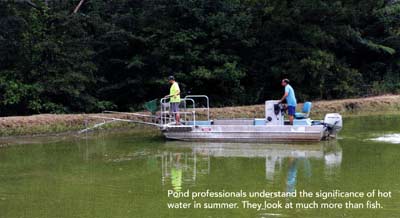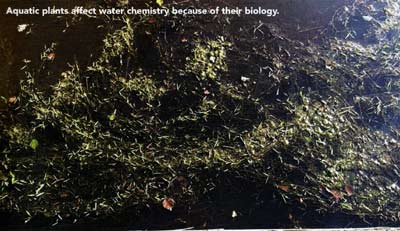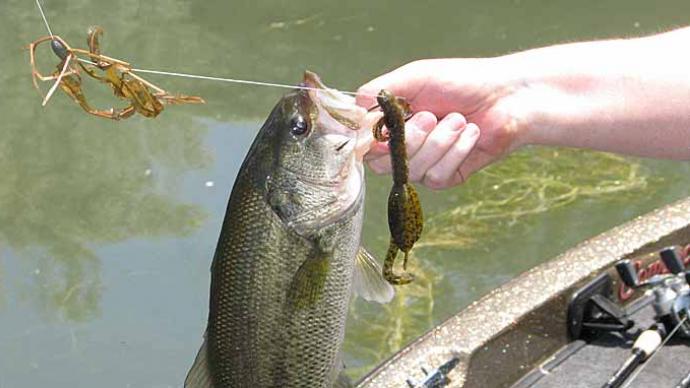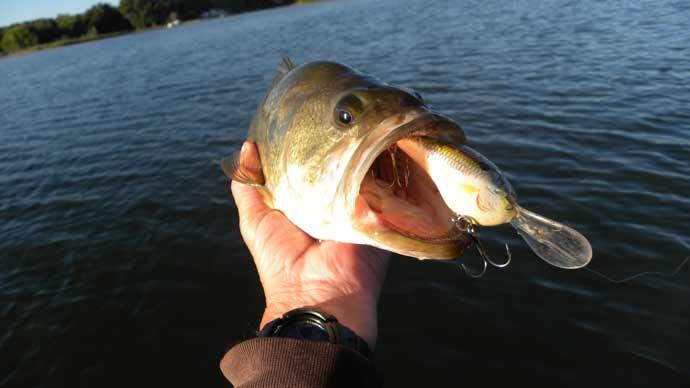
One of the challenges to understanding pond water is how chemistry affects its biology and how biology affects chemistry. A plankton bloom alters pH and dissolved oxygen levels. So does a thick mat of aquatic plants. Add some physics of water to this equation, and it gets a little more complicated.
Let's simplify some of this science.
Facts: Water's affinity for oxygen falls as temperature rises. That means water can't naturally hold as much oxygen in summer as it can in winter. But that truth is hedged as plants do what they do to add oxygen—or use it. Think of photosynthesis during longer days and respiration at night. Water temperature in the 80s tends to hold 6 to 8 parts per million, but I've measured it as high as 12. How can that be? Water seems to want to stabilize at about 85% saturation for oxygen in summer, but it can skyrocket when checking during the late afternoon. I've read high numbers of oxygen on a meter, then laid on my belly on a dock, stared down into the mats of plants under water, and watched little bubbles breaking loose and floating from the plants. Plants are producing more oxygen than the water can relieve itself. That's why we can often measure super-saturated levels of oxygen late afternoon. It's produced faster than it can leave.
Here's another fact. If that same mass of plants can send oxygen levels so high, guess what? It can do the converse at night. Longer periods of sunlight are in your pond's favor.. until three or four days of summer cloud cover inhibits photosynthesis. When that happens, dissolved oxygen level spikes, high late in the afternoon, lowest about dawn. If the highest spike drops, then the lowest spike can be fatal. Think oxygen depletion.
While water is doing what it does, it affects the fishery, too.
More fact: Fish metabolism escalates as the temperature rises...to a point. Then, when water is hot, metabolism slows down. With dissolved oxygen levels fluctuating with high spikes, fish-eating, and metabolizing, stir all this stuff in hot summer water, and the whole situation is stressful. Stressed fish won't thrive. They are trying to survive.
Added facts: microscopic algae species compete in the water column based on temperature and nutrients. Nutrients affect what grows. Sunlight penetration is crucial. Different species of algae affect water chemistry via biology.

The take-home point here? Many things are going on invisibly in our lake, in its water. Those often fast-paced phenomena influence our fish. On a microscopic level, if fish cells try to fight against too much oxygen or too little, they don't do as well.
When your pond water is a layer cake, some of it is useless for living things, plants, insects, invertebrates...all the way up the ecological chain to fish.
What's a pondmeister to do?
Job One is to be aware. Understand these basic concepts. When someone calls their pond-pro, desperately wanting a vegetation treatment in July or August, they are battling stronger odds. Risk too many plants dying at once, creating an oxygen depletion, or leave them as is, get those few days of cloud cover, and have an oxygen depletion?
That's why we recommend paying attention to these factors early in the season.
Job Two is measure the risks of action you might take. Think beyond the obvious. If you treat a fourth of those plants, your odds of success are probably pretty good.
Job Three is to hedge your bets. As you think through this fun little conundrum, what can you do to offer basic stability to your favorite fishing hole? I hope you answered out loud. Aeration. Aerating your pond during the summer months can help with several of these water facts. Remember this: water cleanses itself by constantly moving, touching the atmosphere, and exchanging its byproducts either in gases or precipitating, or allowing plants to use what's dissolved, suspended, or absorbed. Aeration helps water stabilize. Aeration helps relieve water of dissolved oxygen spikes, keeps essential nutrients moving in the water column, and adds autonomy to an otherwise spiky existence.
What kind of aeration, you might ask? Check the Pond Boss Resource Guide. Excellent companies on those pages can coach you based on pond type, depth, and goals. Bottom-diffused aeration is popular, but so are circulators and even some types of fountains. There are electric systems, wind-driven and solar-powered systems as well.
Bottom line? The better you understand how water works, the better you will be as a water steward.
Reprinted with permission from Pond Boss Magazine



